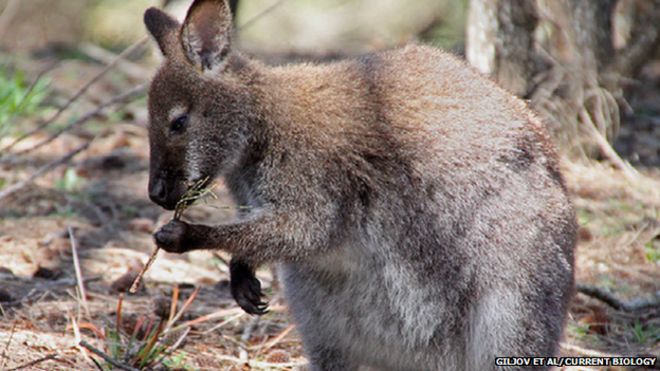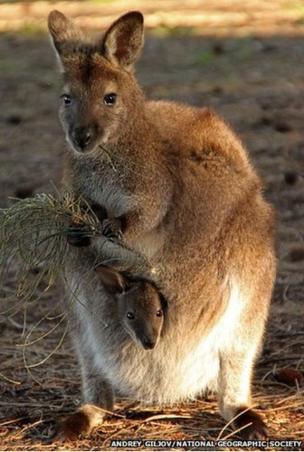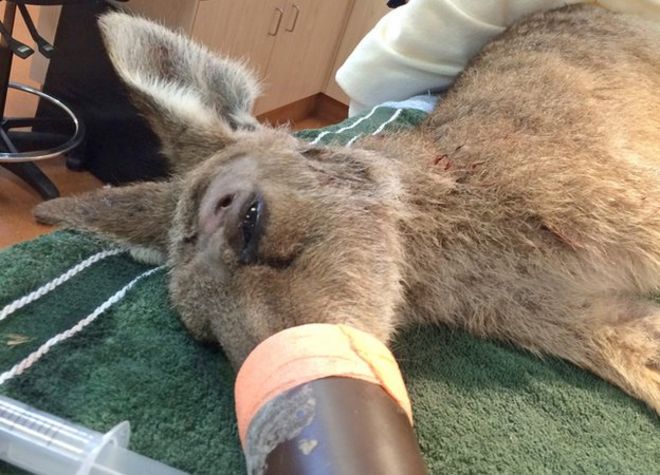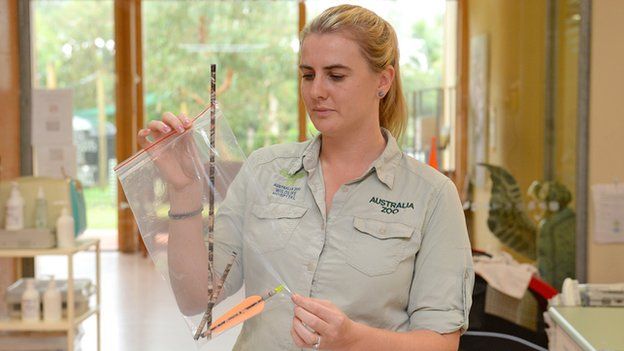88m3
Fast Money & Foreign Objects
Most kangaroos are 'left-handed'

The red-necked wallaby was one of three species found to be predominantly left-handed
Wild kangaroos tend to favour their left hands during common tasks like grooming and feeding, a study suggests.
The researchers say this is the first demonstration of population-level "handedness" in a species other than humans, who are mostly right-handed.
The evidence comes from hours spent observing multiple species in the wild.
Two species of roo and one wallaby all showed the left-handed trend; some other marsupials, which walk on all fours, did not show the same bias.
The research, published in the journal Current Biology, was conducted by Russian scientists from St Petersburg State University, who travelled to Australia to do the fieldwork. There they collaborated with Janeane Ingram, a wildlife ecologist and PhD student at the University of Tasmania.
Ms Ingram told the BBC the work had faced some scepticism.
"Unfortunately, even my own colleagues think that studying left-handedmacropods is not a serious issue, but any study that proves true handedness in another bipedal species contributes to the study of brain symmetry and mammalian evolution," she said.

Proud southpaw: The eastern grey kangaroo
Senior author Dr Yegor Malashichev said there had been a "widespread notion" that handedness was a uniquely human phenomenon, until research in the last 10-20 years showed that asymmetry in behaviour and brain structure was surprisingly widespread.
But examples of left- or right-handedness tended to be specific to particular behaviours, and were not consistent across a population.

The animals were observed in the wild, in Tasmania and New South Wales
"As one of our reviewers pointed out, laterality is also obvious in how parrots hold their food or how your dog shakes hands," Ms Ingram said. "But these examples of lateralisation have not been proven at the population level."
Parallel evolution
The new study found a consistent left-handed bias across eastern grey kangaroos, red kangaroos, and red-necked wallabies - no matter whether the animals were grooming, feeding, or propping themselves up.
In terms of handedness, Dr Malashichev said this confirmed for the first time that "we are not alone in the Universe; we are two - humans and kangaroos".
He and his colleagues suggest that their discovery is an example of "parallel evolution". This is because handedness seems to have appeared in primates, which belong in the group of placental mammals, as well as the marsupials in the new study, but not in related animals across these two branches of the evolutionary tree.
The researchers also argue that posture is an important factor. The left-handed trend was only seen in species that stand upright on their hind legs, using their forelimbs more regularly for tasks other than walking.
Similarly, they suggest, the transition to an upright posture may have been key to primates developing handedness.
It remains to be seen if there are particular aspects of the brain in these marsupials that have allowed handedness to develop - and whether they can explain why kangaroos, in contrast to predominantly right-handed humans, tend to be southpaws.
http://www.bbc.com/news/science-environment-33169547?ocid=socialflow_facebook
- 3 hours ago
- From the sectionScience & Environment

The red-necked wallaby was one of three species found to be predominantly left-handed
Wild kangaroos tend to favour their left hands during common tasks like grooming and feeding, a study suggests.
The researchers say this is the first demonstration of population-level "handedness" in a species other than humans, who are mostly right-handed.
The evidence comes from hours spent observing multiple species in the wild.
Two species of roo and one wallaby all showed the left-handed trend; some other marsupials, which walk on all fours, did not show the same bias.
The research, published in the journal Current Biology, was conducted by Russian scientists from St Petersburg State University, who travelled to Australia to do the fieldwork. There they collaborated with Janeane Ingram, a wildlife ecologist and PhD student at the University of Tasmania.
Ms Ingram told the BBC the work had faced some scepticism.
"Unfortunately, even my own colleagues think that studying left-handedmacropods is not a serious issue, but any study that proves true handedness in another bipedal species contributes to the study of brain symmetry and mammalian evolution," she said.

Proud southpaw: The eastern grey kangaroo
Senior author Dr Yegor Malashichev said there had been a "widespread notion" that handedness was a uniquely human phenomenon, until research in the last 10-20 years showed that asymmetry in behaviour and brain structure was surprisingly widespread.
But examples of left- or right-handedness tended to be specific to particular behaviours, and were not consistent across a population.

The animals were observed in the wild, in Tasmania and New South Wales
"As one of our reviewers pointed out, laterality is also obvious in how parrots hold their food or how your dog shakes hands," Ms Ingram said. "But these examples of lateralisation have not been proven at the population level."
Parallel evolution
The new study found a consistent left-handed bias across eastern grey kangaroos, red kangaroos, and red-necked wallabies - no matter whether the animals were grooming, feeding, or propping themselves up.
In terms of handedness, Dr Malashichev said this confirmed for the first time that "we are not alone in the Universe; we are two - humans and kangaroos".
He and his colleagues suggest that their discovery is an example of "parallel evolution". This is because handedness seems to have appeared in primates, which belong in the group of placental mammals, as well as the marsupials in the new study, but not in related animals across these two branches of the evolutionary tree.
The researchers also argue that posture is an important factor. The left-handed trend was only seen in species that stand upright on their hind legs, using their forelimbs more regularly for tasks other than walking.
Similarly, they suggest, the transition to an upright posture may have been key to primates developing handedness.
It remains to be seen if there are particular aspects of the brain in these marsupials that have allowed handedness to develop - and whether they can explain why kangaroos, in contrast to predominantly right-handed humans, tend to be southpaws.
http://www.bbc.com/news/science-environment-33169547?ocid=socialflow_facebook






